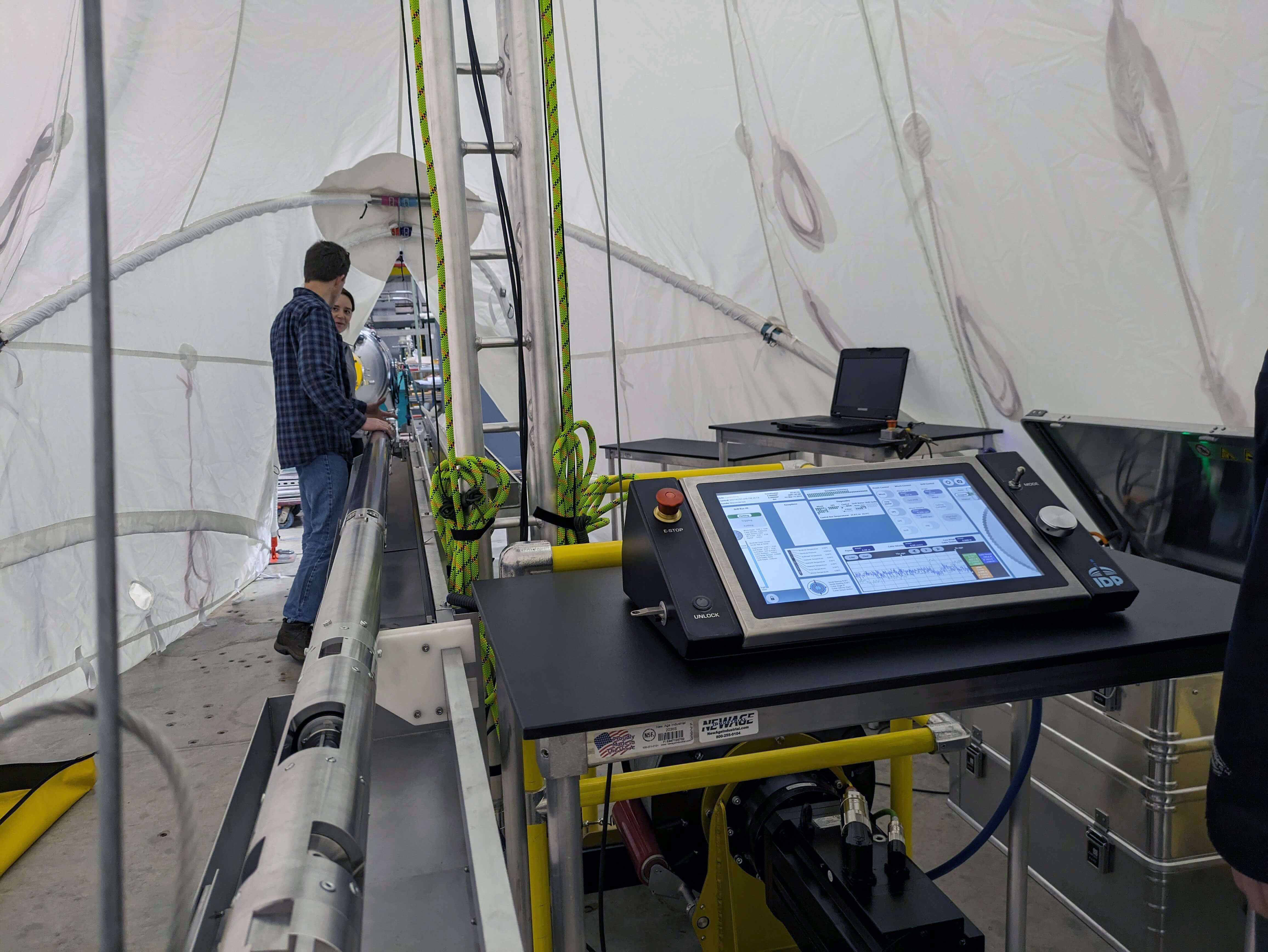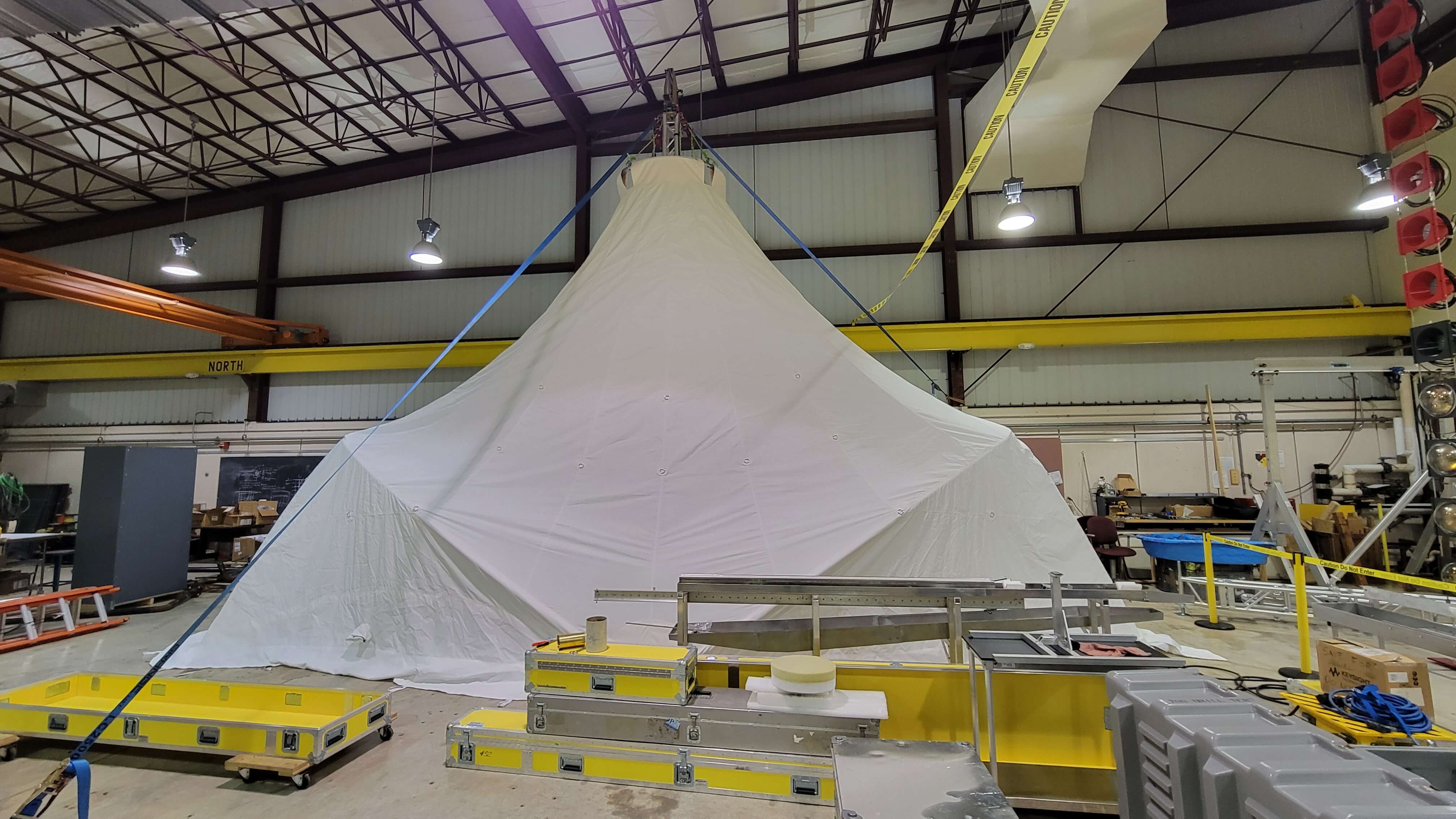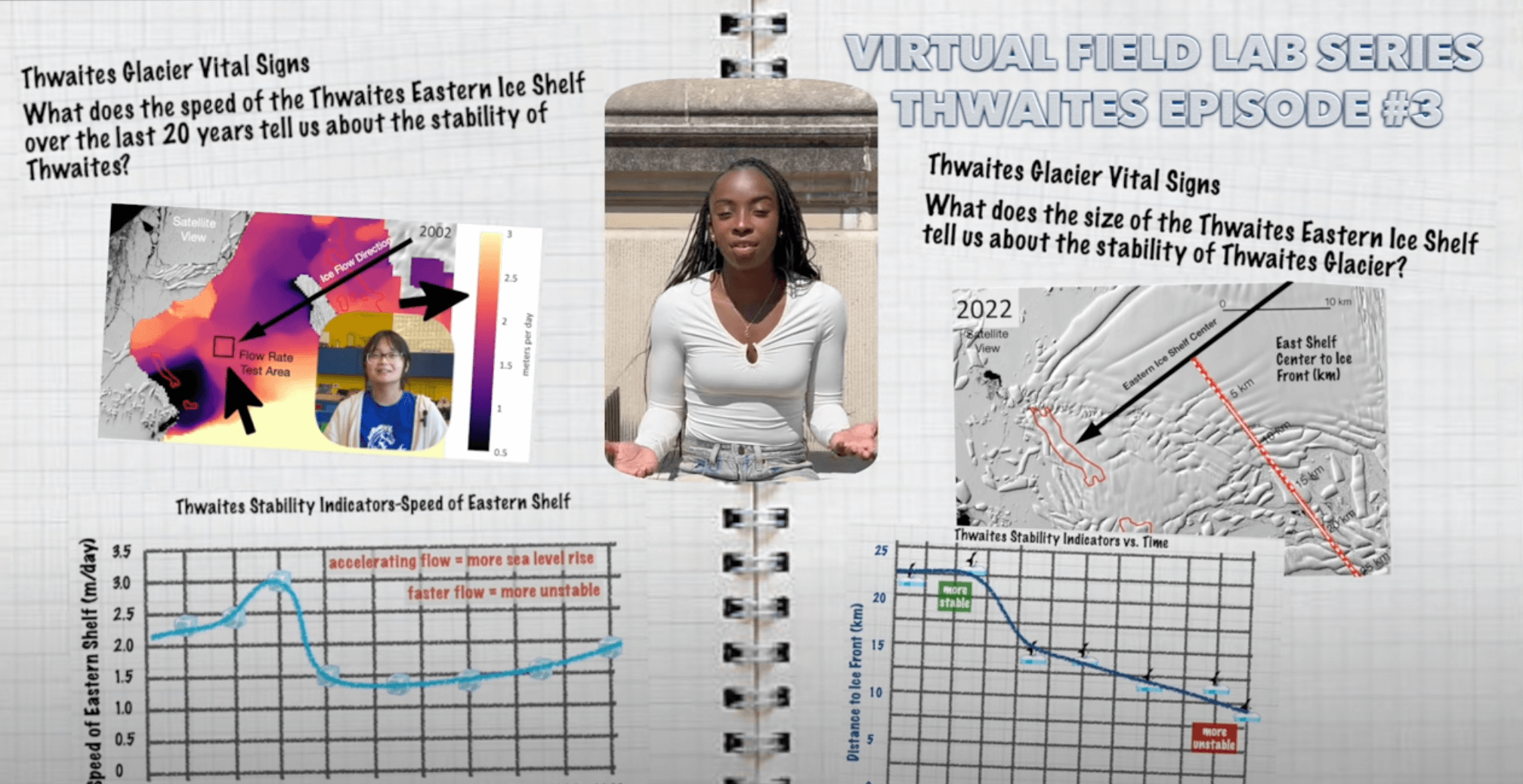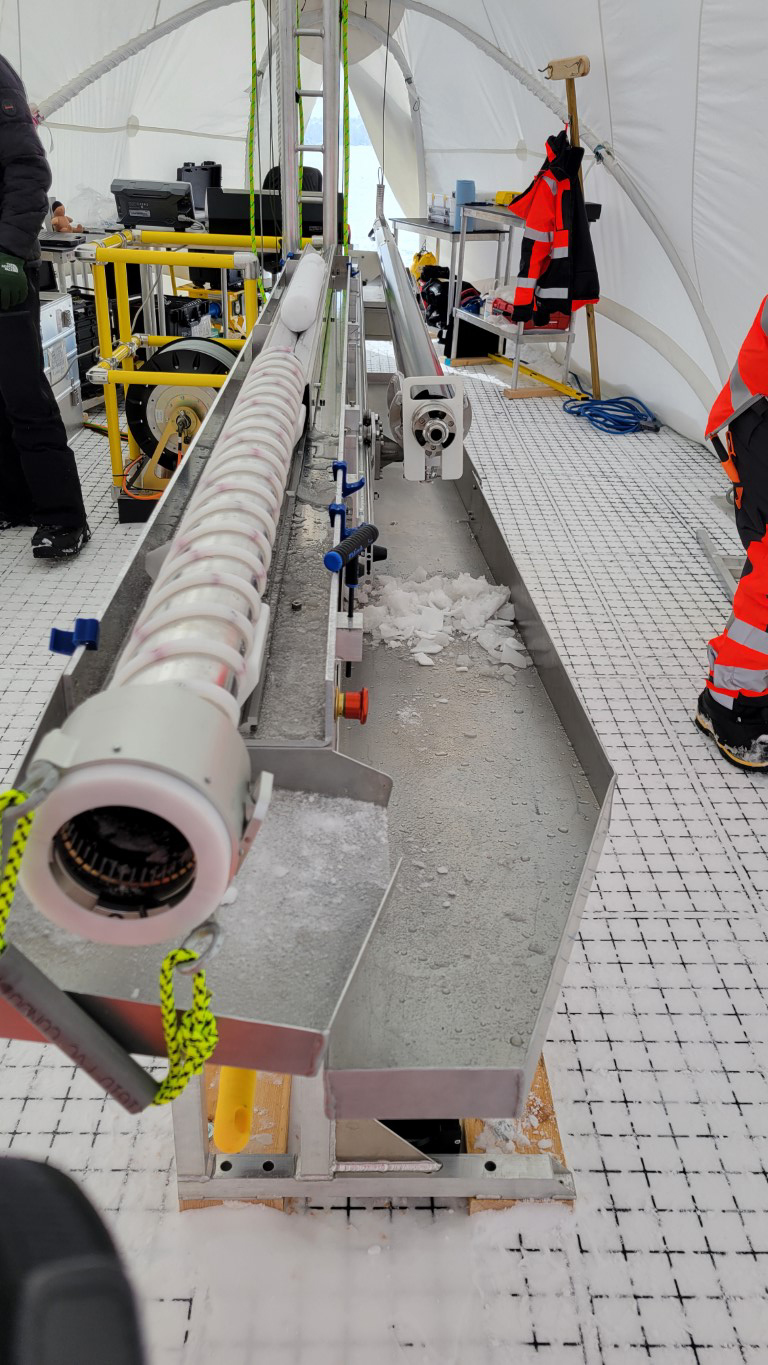New 700 Drill System Ready for Action
- 700 Drill
In February and March, IDP engineers spent some time at the UW-Madison Physical Sciences Lab (PSL), putting the 700 Drill winch and control system through its paces. The winch and tower were set up over a cased hole in the ground, and a portion of the drill sonde and a weight were attached to the cable. IDP Electrical Engineer Umberto Stefanini spent several days inside an Eskimo work tent working to test and troubleshoot the control system. Following the outdoor testing, the drill tent was set up inside an adjacent facility at PSL. In April, the drill was set up at the IDP facility to facilitate final in-house testing of the control software, slide rail assembly for laying the drill down, and the core handling and chips/fluid handling trays and assemblies. The drill was disassembled in late April, and packing began for shipment to Scotia, NY, in early May. The drill will be tested and used at Summit Station in June and July to support PI Eric Saltzman’s project.
IDP Education and Outreach Climate of HOPE Conference for Teachers
- Education/ Outreach
- Meetings/ Workshops
The IDP-sponsored Climate of HOPE conference was held on March 1, 2024. The workshop was held at Downers North High School in DuPage County, IL, where a unique county-wide in-service day occurs each spring. Four hundred DuPage County middle and high school science teachers attended the conference. The goal of the Climate of HOPE conference was to bring a combination of cutting-edge climate research and engaging classroom-ready activities to Illinois science teachers. The conference explored the confluence of inquiry, climate science, and evolution as they relate to our rapidly changing planet. IDP invited three keynote speakers, Dr. Richard Alley (Penn State), Frank Niepold (NOAA Climate Program Office), and Dr. Alden Adolph (St. Olaf College), and organized seven break-out sessions featuring three Train the Trainers Workshop participants and IDP engineer Jay Johnson and IDP Director of Operations Krissy Slawny from IDP at the University Wisconsin-Madison. Other workshop sponsors included the National Center for Science Education (NCSE), DuPage County Regional Office of Education (DROE), and Illinois Science Teachers Association (ISTA).
All Episodes Now Available - Sea Level Rise and Thwaites Glacier: Vital Signs of the Doomsday Glacier
- Education/ Outreach
All three episodes of IDP’s latest Virtual Field Lab (VFL), Sea Level Rise and Thwaites Glacier: Vital Signs of the Doomsday Glacier, are now available. In the VFL, Dr. Richard and Dr. Karen Alley take students to Antarctica to analyze the stability of Thwaites Glacier. Three vital signs (the speed of the glacier over the last 20 years, the changing size of the Thwaites Eastern Ice Shelf, and the number of crevasses on the Eastern Ice Shelf over the last 20 years) are examined throughout the series to assess how this glacier may single-handedly impact future predictions of sea level rise.
The Virtual Field Labs are unique interactive education and outreach products designed for students from late middle school to college. The labs are designed for students to watch with a teacher present (virtually or in-person) or independently on their computers. Each Virtual Field Lab takes students along with a climate scientist as they collect and analyze data to answer a different climate question. There are currently five Virtual Field Labs, each containing three video episodes. Visit the Virtual Field Labs webpage for a description of each lab.
2024 Spring/Summer Fieldwork
- Fieldwork
The second quarter saw the start of the 2024 spring/summer field season. IDP is providing support to the following projects:
(1) The Collaborative Research: GreenDrill: The response of the northern Greenland Ice Sheet to Arctic Warmth - Direct constraints from sub-ice bedrock project (PIs Joerg Schaefer, Jason Briner, Rob DeConto, and Sridhar Anandakrishnan; NSF award numbers 1933927, 1933938, 1934477, 1933802) aims to gather new data to test the sensitivity of the northern Greenland Ice Sheet (GrIS) and its potential to contribute to sea level rise in the future. Specifically, data from the GreenDrill project will better constrain the response of the GrIS to past periods of warmth and address the hypothesis that the northern GrIS is more sensitive to Arctic warming than the southern GrIS. During the project’s second field season, the team will use the Winkie Drill to drill in northern Greenland to obtain bedrock samples from below the ice sheet and, if successful, analyze a suite of cosmogenic nuclides (Beryllium-10, Aluminum-26, Chlorine-36, Carbon-14, and Neon-21) in the bedrock samples that can act as signatures of changes to the GrIS margin. These data will deliver direct observations of periods when the GrIS was substantially smaller than today, and ice sheet margins retreated inland. Results will be incorporated into a numerical ice sheet model with a built-in cosmogenic nuclide module to identify plausible ice sheet histories. The modeling experiments will help understand the mechanisms and climate forcing underlying past periods of ice sheet retreat and help inform predictions of the future. A first-order map of sea level rise fingerprints and inundation scenarios for major port cities will be produced based on the melting scenarios
(2) The Atmospheric H2 in the Northern Hemisphere over the past Millennium project (PI Eric Saltzman; NSF award number 2243540) will analyze molecular hydrogen (H2) in an ice core from Summit, Greenland, to reconstruct atmospheric changes in H2 over the past millennium. Using the 700 Drill, the project will drill a new ice core at Summit and extract air from the samples in the field, with subsequent analysis for H2, Ne, and CH4. This will be the first record of past atmospheric H2 prior to the onset of the industrial era. The results will reveal the natural variability in paleo-atmospheric H2 and how it relates to climate change. The resulting data will provide a baseline for assessing how human activities have influenced atmospheric H2 since the preindustrial era. The results of this study will inform global assessments of how the future hydrogen economy will affect atmospheric composition and climate.
(3) The Collaborative Research: AON Network for Observing Transformation of the Greenland Ice Sheet Firn Layer project (PIs Joel Harper and Toby Meierbachtol; NSF award numbers 2113391 and 2113392) will establish a network of instrumented sites to observe the transformation of the Greenland Ice sheet’s percolation zone firn layer. Using the IDDO Hand Auger and Sidewinder, repeat cores will be collected over five years to track density and ice content changes, and instrumentation installed in core holes will monitor firn temperature evolution and compaction of the firn layer. The data from these efforts will be of high value to scientists focused on changes in storage capacity of the firn layer, process details of meltwater infiltration in cold firn, and the influence of firn compaction and melt on satellite-observed ice sheet elevation.
(4) The NSFGEO-NERC: Collaborative Research: Chemistry and Biology under Low Flow Hydrologic Conditions Beneath the Greenland Ice Sheet Revealed through Naturally Emerging Subglacial Water project (PIs Kathy Licht and Trinity Hamilton; NSF award numbers 2039854 and 2039582) seeks to understand the effect of large glaciers on weathering processes beneath the Greenland Ice Sheet and the consequences for life. During summer, nutrients and other products are flushed out of the Greenland Ice Sheet with water from melting ice. While these products have been sampled in spring and summer, it is not known how weathering processes are different during winter. In this project, researchers used a SIPRE Hand Auger to sample the seasonal ice that forms in front of two of Greenland’s glacial outlets, Isunnguata Sermia and Leverett Glacier, during the freezing months to assess the chemistry and microbiology processes that reflect wintertime conditions beneath the ice sheet – periods when input of fresh meltwater is minimal. These samples will increase knowledge of winter conditions under the Greenland Ice Sheet and help better understand the interior portions of the ice sheet, which are largely inaccessible. Such information will help assess past conditions when colder atmospheric conditions resulted in minimal meltwater input through the ice sheet and to the glacial bed. These analyses will inform understanding of the role of glaciers on earth’s nutrient cycles presently, under past ice age conditions, and in a future deglaciating world.
(5) IDP Driller Training Opportunity (PI Mary Albert; NSF award number 1836328) seeks to cross-train IDP engineers and support staff on the operation of several NSF-owned drills maintained by IDP. IDP Lead Engineer Jay Johnson, who is overseeing the use of the 700 Drill at Summit Station, Greenland, for PI Eric Saltzman’s project, will cross-train IDP Engineers Barb Birrittella, Umberto Stefanini, Andrew Haala, and Field Support Manager Jess Ackerman on operation of the new 700 Drill, the Foro 400 Drill, an Eclipse Drill, and the Chipmunk Drill. The team will also test the recently fabricated Sidewinder prototype with an IDDO Hand Auger. As IDP and its international colleagues navigate challenges with a shortage of trained and experienced equipment operators, this opportunity provided by NSF and supported by Battelle ARO will help additional IDP staff gain familiarity with several drill systems that regularly deploy to the Arctic and Antarctic.
(6) The CAREER: Characterizing Climate Change Feedbacks in Arctic Ponds while Incorporating Next-Generation Technologies and Arctic Field Experiences in Education project (PI Christian Andresen; NSF award number 2239038) will characterize the role of Arctic wetland ponds in regional land-atmosphere carbon exchange, estimate their contributions of methane to the atmosphere, and assess how they have changed over the past 50 years to better anticipate their future role in Arctic carbon cycling and feedbacks to climate. Wetlands represent a significant portion of the Arctic landscape and are characterized by their numerous polygonal thaw ponds. These Arctic pond habitats are hotspots for biodiversity and carbon cycling. Particularly, ponds are key emitters of methane, a potent greenhouse gas that enhances climate change. The researchers will use a SIPRE Hand Auger to assist in setting up eddy covariance flux towers that measure meteorological information, and methane and carbon dioxide fluxes from tundra ponds.
Science Advisory Board 2024 Meeting
- Science Advisory Board
- Long Range Plans
- Ice Core Working Group
- Englacial and Subglacial Access Working Group
The U.S. Ice Drilling Program (IDP) convenes a Science Advisory Board (SAB) to form and update the Long Range Science Plan that addresses multiple aspects of ice core and other ice science and associated technology. The annual SAB meeting was held in-person on February 15-16, 2024, in Arlington, VA. The first part of the meeting was an open session and included updates from IDP, the NSF Ice Core Facility, the Ice Core Working Group, and the Englacial and Subglacial Access Working Group (ESAWG). It also included discussions regarding ESAWG planning, and Safe and Inclusive Plan templates. The second part of the meeting was a closed session in which the SAB prioritized the technology investments outlined in the Long Range Science Plan and discussed SAB member rotation and SAB Terms of Reference.
The members of the SAB are:
- T.J. Fudge, Chair (University of Washington)
- Joel Harper (University of Montana)
- Matthew Siegfried (Colorado School of Mines)
- Sarah Shackleton (Woods Hole Oceanographic Institution)
- Martin Truffer (University of Alaska Fairbanks)
- Ryan Venturelli (Colorado School of Mines)
- Trista Vick-Majors (Michigan Technological University)
Ice Core Working Group 2024 Meeting
- Ice Core Working Group
- Long Range Plans
A virtual meeting of the Ice Core Working Group (ICWG) was held on April, 2024, to discuss updates to the Long Range Science Plan (LRSP) and other ICWG business. Discussions included updates from IDP and the NSF Ice Core Facility (NSF-ICF), discussion about the NSF-ICF Use and Ice Core Sample Allocation Policy, NSF-ICF Sample Allocation Committee membership composition, discussion about the Beacon/Mullins Valley cores archived at the NSF-ICF, updates to the LRSP, and ice drilling technology development priorities for the LRSP.
The members of the ICWG are:
- Becky Alexander, Chair (University of Washington)
- T.J. Fudge (University of Washington)
- Alex Michaud (The Ohio State University)
- Summer Burton Rupper (University of Utah)
- Jeff Severinghaus (Scripps Institution of Oceanography)
- Sarah Shackleton (Woods Hole Oceanographic Institution)
- Dom Winski (University of Maine)
2nd RAID Science Planning Workshop
- Meetings/ Workshops
- Long Range Plans
- Rapid Access Ice Drill (RAID)
The U.S. Rapid Access Ice Drill (RAID) is ready for Antarctic ice-sheet exploration! RAID completed successful field trials in the 2019-20 austral season. Since then, RAID has completed a series of important tooling upgrades and technical improvements. With new developments in knowledge of subglacial materials and basal ice-sheet environment, new technologies and micro-instrument methodologies, discovery of very old (up to 4 m.y.) ice from blue ice fields, and an engaged new generation of young cryosphere and solid-earth scientists — now is a good time for a 2nd RAID Science Planning Workshop to reunite the community and articulate the future science that the community wants to do with RAID! Expression of interest and application forms are now officially open until July 15, 2024.
Conveners:
Sarah Shackleton (Woods Hole Oceanographic Institution)
John Goodge (Planetary Science Institute)
Allie Balter-Kennedy (Lamont-Doherty Earth Observatory)
Shuai Yan (University of Texas Institute for Geophysics)
Jeff Severinghaus (Scripps Institution of Oceanography)
Dates: September 25-27, 2024 (including half-day session for Early Career Researchers!)
Location: Herndon, Virginia (near Dulles airport)
Website: https://www.rapidaccessicedrill.org/2nd-raid-science-planning-workshop/
Expression of Interest Deadline: July 15, 2024
Registration Deadline: August 15, 2024
Costs: No registration fee. Meals will be provided to all participants during the Workshop. Rooms in the Workshop hotel will be available at a discounted rate (participants to pay on their own). Travel support is available for 15 Early Career participants (by application).
Workshop goals:
(1) rejuvenate & grow scientific user community for RAID;
(2) enable new generation of early-career scientists in cutting-edge Antarctic research;
(3) promote inter–disciplinary research synergies, including use of new cryosphere technologies;
(4) engage the geophysical community for reconnaissance, site selection & data analysis;
(5) help integrate RAID and COLDEX activities;
(6) stimulate new cross-disciplinary research & proposal collaborations;
(7) develop new concepts to support traverse platforms in Antarctica; and
(8) create a new Long-Range Science Plan for RAID based on community research goals & priorities for future drilling.
The workshop conveners seek a diverse group of participants for this NSF-funded workshop. Space is limited! Reserve your place and participate in this important workshop that will steer the future of RAID as an interdisciplinary research platform for deep ice-sheet access. An Expression of Interest (EOI) form is available for all participants. The deadline for submitting your EOI form is July 15, 2024. This includes an Application for Travel Support for Early Career Researchers.
For detailed information, costs, key dates, and a link to the EOI form, visit the workshop’s website:
https://www.rapidaccessicedrill.org/2nd-raid-science-planning-workshop/
Ice Drilling Support for NSF Polar Proposals
If you are preparing a National Science Foundation (NSF) proposal that includes any kind of support from IDP, you must include a Letter of Support from IDP in the proposal. Researchers are asked to provide IDP with a detailed support request three weeks prior to the date the Letter of Support is required. Early submissions are strongly encouraged.
Scientists who seek to include IDP education and outreach activities associated with U.S. ice coring or drilling science projects should contact Louise Huffman at Louise.T.Huffman@Dartmouth.edu during their proposal preparation stage.
For additional information on requesting IDP support, visit our website at https://icedrill.org/requesting-field-support or contact us at IceDrill@Dartmouth.edu.













